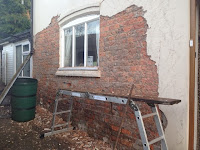Paint is often seen as the gateway into eco products so it is really important to understand and appreciate, but what makes a paint 'eco' and why should we choose them over the more conventional options?
There are a number of reasons and the relevance to your life will be dependent on your sensibilities.
1. The right product
I think that this is the most important reason. Most natural paints are breathable and this means that they allow moisture to pass through them. This is of course really important if you have breathable walls. No point having lovely natural walls and then plastering them with paints that seal them up. So paints like claypaint, lime paint, silicate paint are VITAL to use on breathable walls. Unfortunately many buildings with breathable walls have had conventional (non breathing) emulsions used and this is why the paint bubbles and peels off etc. So by using the right product means that it will last longer, create a healthy environment both for the occupants, but also for the actual building.
In a high traffic area you may also want to have a scrubbable paint. A living room might be demanding an ultra matt finish. A door may need to be shut at night and so a very quick drying paint is needed. Allergies might dictate that synthetic preservatives are not used, .......
2. Environment
Most paints are petro-chemical based and so fundamentally unsustainable. Yes this means that they are very consistent as they are manufactured to death, but it also means that they have synthetic VOCs (Volatile Organic Compounds) that have been shown to cause a range of health issues. However, there is also the issue of carbon footprint. By using petro-chemical carbon based ingredients the environmental impact is increased, as is the waste consideration. Conventional paints are much more difficult for nature to degrade and so they become a legacy waste so we will have to live with their chemical compounds for much longer.
Many of the natural paint manufacturers wish to ensure that they minimise their environmental impacts (well they would won't they!) Auro, for example, are so committed to the environment that they utilise solar power in the manufacturing process, source ingredients organically wherever possible and also from as close to the factory as possible.
3. Health
The VOCs that are given off by conventional paints have resulted in Painting and Decorating being one of those trades that suffer high levels of respiratory illnesses and complaints. Although paints should off-gas all their VOCs within a month, you will still be sitting in a house that is essentially a bit of a toxic soup for that time. Natural paints are virtually all VOC free and so they do not have the same effects on the trades people or the home owners.
4. Quality
Natural paints are not sold in Germany as being 'eco-friendly' they are labelled for one of their other attributes and that is quality. Natural paints tend to be at the highest end of the quality spectrum. Natural paints have great coverage and high opacity / obliteration properties. This tends to mean that you use less paint as it covers so well.
5. Amazing properties
Some natural paint manufacturers have amazing products they may well tick your box. For example Auro have their Airfresh paint that actually cleans the air from pollutants. Earthborn ProAqua Varnish and Eggshell are incredibly quick drying and so allow you to get a finished eggshell finish in a day.
However, it is important to recognise that natural paints are products of their ingredients and so you need to choose the right paint for any particular job. So you may wish to have an earthborn paint in a bedroom so that you have no smell or VOC's at all (there are no oils in earthborn paints), an Auro in the dining room as you love the citrus oil smell and a Green Paint emulsion in the hallway as the soya oil base makes it scrubbable.
We would recommend that you fundamentally base any decision on ensuring that the paint is right one for the location, but that after that you can let your personal concerns and interests guide you.
Natural paints might appear to be more expensive, but you need to compare them to high quality paints not your standard trade emulsions. You will probably find that paints from companies like Farrow and Ball are actually much more expensive and without all the sustainability benefits that you can gain from companies like earthborn and Auro.
Don't be fooled by much of the eco labelling out there either. Always look for companies who will give you a full ingredients list.

